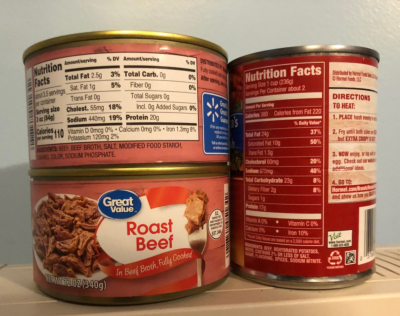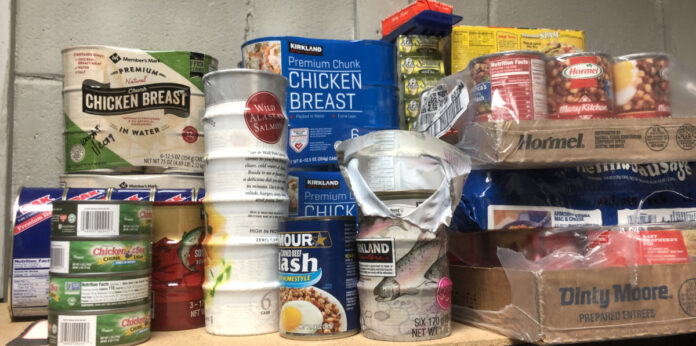Many of the commercial survival food packages out there are very heavy on carbohydrates and light on protein with almost no fats.
You should look at your stored food because you don’t want to find out about the lack of these important nutritional building blocks when you find yourself in a serious survival situation and must rely on the food you have in buckets and #10 cans.
Go down to your basement, out to your garage, into that closet, or wherever else you store your emergency food and inspect your emergency foods. I bet you fill find lots of fruits, grains (rice, wheat oatmeal, and baking mixes like pancake and biscuit mix), pasta (also grain based,) potatoes, with some vegetables (also heavy on carbs). Most of the protein in your commercial package is going to be from things like powdered milk and textured vegetable protein (TVP) which is a polite way of saying soybeans that have been flavored to taste like meat.
The Recommended Daily Value of the big three macronutrients set by the Food and Drug Administration for a 2,000 calorie diet are: 300 grams of carbs, 50 grams of protein, and 78 grams of fat. How close are your stores?
Some Specific Examples
I pulled a bucket of Wise Emergency Food Supply that had 56 servings from our storeroom. Their menu include savory stroganoff (notice the word “beef” is missing because there is no beef in it), chili macaroni, pasta alfredo, creamy pasta and vegetable rotini, teriyaki and rice (again, no beef), cheesy lasagna, hearty tortilla soup, apple cinnamon cereal, brown sugar and multi grain (cereal, we assume), and crunchy granola. That’s five menus with pasta, two of rice, and four based on other grains. Obviously, these grain-based meals are very heavy on carbs.
So that we are not picking only on Wise, we also looked at a bucket of Chef’s Banquet Food Storage Basics on the costco.com website. It included pre-cooked pinto bean, potato flakes, hard red wheat, rolled oats, and rice. All good things to have in your food storage, but all foods that provide almost no fat. In fact, we did the math and the ratio of carbs to fat, which the FDA says should be 3.8 to 1 was 32.5 to 1.
The Dangers of Pre-Packaged Prepper Food
Let me go off on a tangent and complain about how these food buckets are advertised. The Wise bucket says it contains 56 servings of food. The Chef’s Banquet says it has 336. It sounds like the Chef’s Banquet bucket is the way to go, but are we comparing apples to oranges? If you do the math, you’ll find that the Chef’s Banquet bucket contains 34,800 calories. So if you expect to eat 2,000 calories per day, you will find this provides just a 17-day supply of food. At $60, that’s about 0.58 cents per calorie.
The Wise food bucket, on the other hand, averaged about 250 calories per serving and the entrees with cheese or dairy in them had more fat than the cereals, which had almost none. The 56-meal package had less than 11,000 calories and the lowest price we saw for it was $110. That makes it cost a penny per calorie. That may sound cheap until you realize that at one cent per calorie, the 2,000 calories you need per day will cost $20.
The Wise food was close to twice the cost of the Chef’s Banquet on a per-calorie, but it contained more than three times as much fat. There are easier ways to add fat to your long term storage plan, and we’ll get to that below.
Use Caution when Buying Freeze-Dried Foods
When you buy dried or freeze-dried foods, don’t expect much fat. Fat does not store well in the long term and will eventually go rancid. They also try to entice you to buy expensive freeze dried blue berries, strawberries and other fruits that provide taste and maybe some fun, but little of the macronutrients when you have a heavy day of patrolling, chopping firewood, or working in the garden ahead of you. Trust me, unless you don’t eat meat, go for a meaty entrée and you will get much better value in freeze-dried foods.
We like and recommend Mountain House freeze dried meals with the warning that they are far from cheap. Take Mountain House’s Beef Stew. its first ingredient is potatoes. (Maybe they should call it potato stew with beef.) On a positive note, it contains actual beef has 8 grams of fat and 10 grams of protein per 200 calorie serving. The carbs are more balanced as well, with only 24.
Mountain House’s Chili Mac with Beef (one of their best-sellers) has 230 calories per serving with twice as much protein and two to three times as much fat as the average Wise meals. Unfortunately, Mountain House meals are much more expensive, with $40 for a #10 can of Chili Mac providing only 2,300 calories. That’s 1.74 cents per calorie.
You can buy a #10 can of Mountain House Diced beef for $82.99 and get 15 servings of 110 calories each. That’s about 5 cents per calorie. Now in return for that expenditure, you get a 30 year shelf life and no preservatives.
The Simple, Inexpensive Solution
So, what is a budget minded prepper to do?
Our advice is to go to Walmart and buy four or five cans of their Great Value roast beef for $2.50 each. 4 cans would be 14 servings, also of 110 calories, and you’d spend $10. The shelf life is only three years, but that’s OK because we all know they will last longer, and you can always eat it in the meantime and just buy more. The Walmart beef is about 0.75 cents per calorie or 1/7th the cost of the freeze-dried beef.
Do you want a better buy? A can of Spam contains 1080 calories and when you buy it in an 8-pack at Costco, it’s $2.62 per can. That’s 0.24 cents per calorie. In other words, it’s about 1/20th the cost of the freeze dried beef on a per-calorie basis. And the Spam has far more fat, which your brain and your body need.

Many Americans stress a low-fat diet, but that’s the last thing you will want when your primary mode of transportation becomes your feet.
Canned foods are heavier if you have to tote them around on your back, and they don’t have a 25 or 30-year shelf life for freeze-dried foods, but I find the lower cost wins me over. It’s a tradeoff I will make. Plus, we follow the layered approach to prepping, so we have some freeze-dried meals and a few buckets of pouches as well as canned foods.
Don’t Pay Too Much
The problem with paying too much for your preparedness food is that when you pay $83 for 15 servings, you can’t afford as many servings. If you have a $1,000 budget, your canned meats will provide far more calories, servings, and meals than specialized commercial prepping packages, especially when combined with grains. Our advice is to buy these common pantry foods first and only when you have a three-to-six month supply should you branch out into expensive long-term storage foods.

Above is a chart showing you some available canned meats, the number of servings, the macronutrients per serving, and the cost per calorie. Some meals like beef stew, corned beef, chicken with dumplings and chili are a meal unto themselves. Serve some of the other foods with rice, pasta, bread, potatoes or some of those other starchy, carb-heavy ingredients in your long-term storage food, and you’ll not only resolve the lack of these nutrients, but you’ll have tastier, more fulfilling meals during a time when you need the calories and nutrients to support hard work.
For cost savings, and availability of the macronutrients protein and fat, both of which are often missing in prepper foods, it is hard to beat traditional canned foods.








